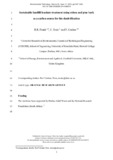JavaScript is disabled for your browser. Some features of this site may not work without it.
| dc.contributor.author | Frank, R. R. | |
| dc.contributor.author | Trois, C. | |
| dc.contributor.author | Coulon, Frederic | |
| dc.date.accessioned | 2016-10-27T14:45:00Z | |
| dc.date.available | 2016-10-27T14:45:00Z | |
| dc.date.issued | 2014-12-17 | |
| dc.identifier.citation | Frank, R. R., Trois, C., Coulon, F. (2014) Sustainable landfill leachate treatment using refuse and pine bark as a carbon source for biodenitrification. Environmental Technology, Vol. 36, Iss. 11, pp1347-1358 | en_UK |
| dc.identifier.issn | 0959-3330 | |
| dc.identifier.uri | http://dx.doi.org/10.1080/09593330.2014.989279 | |
| dc.identifier.uri | http://dspace.lib.cranfield.ac.uk/handle/1826/10892 | |
| dc.description.abstract | Raw and 10-week composted commercial garden refuse (CGR) materials and pine bark (PB) mulch were evaluated for their potential use as alternative and sustainable sources of carbon for landfill leachate bio-denitrification. Dynamic batch tests using synthetic nitrate solutions of 100, 500 and 2000 mg NO3 L−1 were used to investigate the substrate performance at increasing nitrate concentrations under optimal conditions. Further to this, sequential batch tests using genuine nitrified landfill leachate with a concentration of 2000 mg NO3 L−1 were carried out to evaluate substrates behaviour in the presence of a complex mixture of chemicals present in leachate. Results showed that complete denitrification occurred in all conditions, indicating that raw and composted CGR and PB can be used as sustainable and efficient media for landfill leachate bio-denitrification. Of the three substrates, raw garden refuse yields the fastest denitrification rate followed by 10-week composted CGR and PB. However, the efficiency of the raw CGR was lower when using genuine leachate, indicating the inhibitory effect of components of the leachate on the denitrification process. Ten-week composted CGR performed optimally at low nitrate concentrations, while poor nitrate removal ability was found at higher nitrate concentrations (2000 mg L−1). In contrast, the PB performance was 3.5 times faster than that of the composted garden refuse at higher nitrate concentrations. Further to this, multi-criteria analysis of the process variables provided an easily implementable framework for the use of waste materials as an alternative and sustainable source of carbon for denitrification. | en_UK |
| dc.language.iso | en | en_UK |
| dc.publisher | Taylor & Francis | en_UK |
| dc.rights | This is an Accepted Manuscript of an article published by Taylor & Francis in Environmental Technology on 17/12/2014, available online: http://www.tandfonline.com/10.1080/09593330.2014.989279.” | en_UK |
| dc.rights | Attribution-Non-Commercial 3.0 Unported (CC BY-NC 3.0) You are free to: Share — copy and redistribute the material in any medium or format, Adapt — remix, transform, and build upon the material. The licensor cannot revoke these freedoms as long as you follow the license terms. Under the following terms: Attribution — You must give appropriate credit, provide a link to the license, and indicate if changes were made. You may do so in any reasonable manner, but not in any way that suggests the licensor endorses you or your use. Information: Non-Commercial — You may not use the material for commercial purposes. No additional restrictions — You may not apply legal terms or technological measures that legally restrict others from doing anything the license permits. | en_UK |
| dc.subject | Denitrification | en_UK |
| dc.subject | Leachate treatment | en_UK |
| dc.subject | Carbon source | en_UK |
| dc.subject | Pine bark | en_UK |
| dc.subject | Commercial garden refuse | en_UK |
| dc.title | Sustainable landfill leachate treatment using refuse and pine bark as a carbon source for biodenitrification | en_UK |
| dc.type | Article | en_UK |
Files in this item
This item appears in the following Collection(s)
-
Staff publications (SWEE) [2825]
